Fiber-Based Polarization Beam Combiners/Splitters, 1 SM and 2 PM Ports
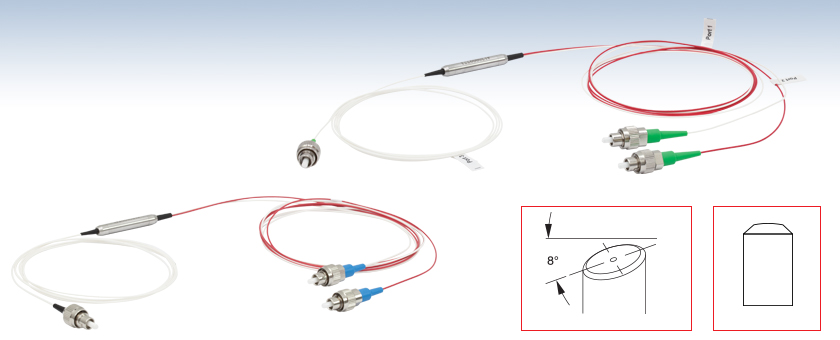
- Combine or Split Orthogonal Polarizations
- 780, 980, 1064, and 1550 nm Operating Wavelengths
- Ideal for Combining Pump Laser Signals Prior to Amplification
Single Mode
Fiber
PBC1550SM-FC
Polarization-
Maintaining Fibers
Single Mode
Fiber
Polarization-
Maintaining Fibers
PBC1064SM-APC
FC/APC
FC/PC

Please Wait
| General Specificationsa | |
|---|---|
| Return Loss | FC/PC Connectors: ≥40 dB FC/APC Connectors: ≥45 dB |
| Damage Threshold | 300 mW (CW) |
| Fiber Length | 1 m on Each Leg |
| Length Tolerance | +0.075 m / -0 m |
| Jacket | Ø900 µm Loose Furcation Tubing |
| Size | 1.38 " x Ø0.22" (35.0 mm x Ø5.5 mm) |
| Connector Keys | Narrow (2.0 mm); Aligned to Slow Axis for all PM Fiber Legs |
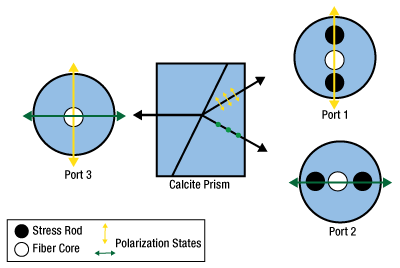
Click to Enlarge
Figure 1.1 Polarization Beam Combiner/Splitter, 2 PM Ports
Features
- Combine or Split Orthogonal Polarizations in Fiber Optic Systems
- High Extinction Ratio
- Bidirectional: One Single Mode Port and Two Polarization-Maintaining Ports
- 1 m of Ø900 µm Jacketed Fiber on Each Leg
- Choose from FC/PC or FC/APC Connectors
Thorlabs' Single Mode Fiber-Based Polarization Beam Combiners (PBC) or Splitters are designed to either combine two orthogonal polarizations into a single fiber or split a single input into its orthogonal linear polarizations through two fiber outputs. The devices on this page feature two legs of polarization-maintaining (PM) fiber on one side of a calcite prism and a single mode (SM) fiber on the other. The legs on the side with the two PM fibers have the slow axis of the fiber aligned for maximum transmission of one polarization state.
Our single mode PBC features one leg of single mode fiber and two legs of polarization-maintaining fiber as shown in Figure 1.1. If an unpolarized signal is sent into the single mode fiber (port 3), the calcite prism splits the light into orthogonal linear polarizations. The slow axis of each PM fiber is aligned to each of the polarized beams emitted from the prism (ports 1 and 2).
This PBC can also be used in reverse to combine two orthogonal polarizations from the PM fiber legs into one single mode output. Light incident on ports 1 and 2 should be aligned to the slow axis. Light incident at ports 1 and 2 aligned to the fast axis of the fibers will refract differently through the prism and will not exit port 3.
These polarization beam combiners are frequently utilized to combine the light from two pump lasers into a single fiber to increase the input into an erbium-doped fiber amplifier or Raman amplifier.
Alternative PBC Options
Versions of our fiber-based PBCs using polarization-maintaining fiber for all three legs are available here. Thorlabs also offers the FiberBench system, which is a line of products designed for free-space manipulation of light within fiber-based systems. This line includes polarizer and beamsplitter modules for constructing custom PBCs. A prebuilt FiberBench-based variable polarization beam combiner / splitter is also available.
| Fiber Polarization Combiner / Splitter Selection Guide | |||
|---|---|---|---|
| Fused Fiber | In-Line Micro Prism | Free-Space Polarization Beamsplitter Kits |
|
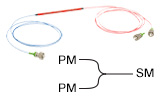 |
 |
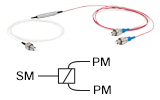 |
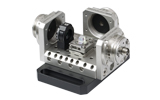 |
| 2 PM Ports, 1 SM Port | 3 PM Ports | 1 SM Port, 2 PM Ports | 3 FiberPort Assembly |
| Higher Power Handling and Higher Transmission | Bi-Directional, Polarizing, Larger Bandwidth | Can be Used with Multiple Fiber Types | |
| Quick Links |
|---|
| Damage at the Air / Glass Interface |
| Intrinsic Damage Threshold |
| Preparation and Handling of Optical Fibers |
Laser-Induced Damage in Silica Optical Fibers
The following tutorial details damage mechanisms relevant to unterminated (bare) fiber, terminated optical fiber, and other fiber components from laser light sources. These mechanisms include damage that occurs at the air / glass interface (when free-space coupling or when using connectors) and in the optical fiber itself. A fiber component, such as a bare fiber, patch cable, or fused coupler, may have multiple potential avenues for damage (e.g., connectors, fiber end faces, and the device itself). The maximum power that a fiber can handle will always be limited by the lowest limit of any of these damage mechanisms.
While the damage threshold can be estimated using scaling relations and general rules, absolute damage thresholds in optical fibers are very application dependent and user specific. Users can use this guide to estimate a safe power level that minimizes the risk of damage. Following all appropriate preparation and handling guidelines, users should be able to operate a fiber component up to the specified maximum power level; if no maximum is specified for a component, users should abide by the "practical safe level" described below for safe operation of the component. Factors that can reduce power handling and cause damage to a fiber component include, but are not limited to, misalignment during fiber coupling, contamination of the fiber end face, or imperfections in the fiber itself. For further discussion about an optical fiber’s power handling abilities for a specific application, please contact Thorlabs’ Tech Support.
Damage at the Air / Glass Interface
There are several potential damage mechanisms that can occur at the air / glass interface. Light is incident on this interface when free-space coupling or when two fibers are mated using optical connectors. High-intensity light can damage the end face leading to reduced power handling and permanent damage to the fiber. For fibers terminated with optical connectors where the connectors are fixed to the fiber ends using epoxy, the heat generated by high-intensity light can burn the epoxy and leave residues on the fiber facet directly in the beam path.
| Table 36C Estimated Optical Power Densities on Air / Glass Interfacea | ||
|---|---|---|
| Type | Theoretical Damage Thresholdb | Practical Safe Levelc |
| CW (Average Power) |
~1 MW/cm2 | ~250 kW/cm2 |
| 10 ns Pulsed (Peak Power) |
~5 GW/cm2 | ~1 GW/cm2 |
Damage Mechanisms on the Bare Fiber End Face
Damage mechanisms on a fiber end face can be modeled similarly to bulk optics, and industry-standard damage thresholds for UV Fused Silica substrates can be applied to silica-based fiber. However, unlike bulk optics, the relevant surface areas and beam diameters involved at the air / glass interface of an optical fiber are very small, particularly for coupling into single mode (SM) fiber. therefore, for a given power density, the power incident on the fiber needs to be lower for a smaller beam diameter.
Table 36C lists two thresholds for optical power densities: a theoretical damage threshold and a "practical safe level". In general, the theoretical damage threshold represents the estimated maximum power density that can be incident on the fiber end face without risking damage with very good fiber end face and coupling conditions. The "practical safe level" power density represents minimal risk of fiber damage. Operating a fiber or component beyond the practical safe level is possible, but users must follow the appropriate handling instructions and verify performance at low powers prior to use.
Calculating the Effective Area for Single Mode Fibers
The effective area for single mode (SM) fiber is defined by the mode field diameter (MFD), which is the cross-sectional area through which light propagates in the fiber; this area includes the fiber core and also a portion of the cladding. To achieve good efficiency when coupling into a single mode fiber, the diameter of the input beam must match the MFD of the fiber.
As an example, SM400 single mode fiber has a mode field diameter (MFD) of ~Ø3 µm operating at 400 nm, while the MFD for SMF-28 Ultra single mode fiber operating at 1550 nm is Ø10.5 µm. The effective area for these fibers can be calculated as follows:
SM400 Fiber: Area = Pi x (MFD/2)2 = Pi x (1.5 µm)2 = 7.07 µm2 = 7.07 x 10-8 cm2
SMF-28 Ultra Fiber: Area = Pi x (MFD/2)2 = Pi x (5.25 µm)2 = 86.6 µm2 = 8.66 x 10-7 cm2
To estimate the power level that a fiber facet can handle, the power density is multiplied by the effective area. Please note that this calculation assumes a uniform intensity profile, but most laser beams exhibit a Gaussian-like shape within single mode fiber, resulting in a higher power density at the center of the beam compared to the edges. Therefore, these calculations will slightly overestimate the power corresponding to the damage threshold or the practical safe level. Using the estimated power densities assuming a CW light source, we can determine the corresponding power levels as:
SM400 Fiber: 7.07 x 10-8 cm2 x 1 MW/cm2 = 7.1 x 10-8 MW = 71 mW (Theoretical Damage Threshold)
7.07 x 10-8 cm2 x 250 kW/cm2 = 1.8 x 10-5 kW = 18 mW (Practical Safe Level)
SMF-28 Ultra Fiber: 8.66 x 10-7 cm2 x 1 MW/cm2 = 8.7 x 10-7 MW = 870 mW (Theoretical Damage Threshold)
8.66 x 10-7 cm2 x 250 kW/cm2 = 2.1 x 10-4 kW = 210 mW (Practical Safe Level)
Effective Area of Multimode Fibers
The effective area of a multimode (MM) fiber is defined by the core diameter, which is typically far larger than the MFD of an SM fiber. For optimal coupling, Thorlabs recommends focusing a beam to a spot roughly 70 - 80% of the core diameter. The larger effective area of MM fibers lowers the power density on the fiber end face, allowing higher optical powers (typically on the order of kilowatts) to be coupled into multimode fiber without damage.
Damage Mechanisms Related to Ferrule / Connector Termination
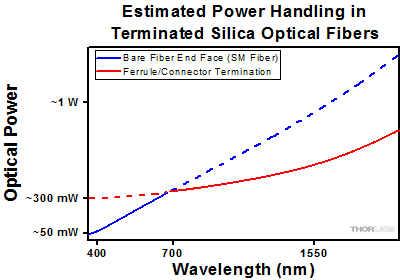 Click to Enlarge
Click to EnlargeFigure 36D Plot showing approximate input power that can be incident on a single mode silica optical fiber with a termination. Each line shows the estimated power level due to a specific damage mechanism. The maximum power handling is limited by the lowest power level from all relevant damage mechanisms (indicated by a solid line).
Fibers terminated with optical connectors have additional power handling considerations. Fiber is typically terminated using epoxy to bond the fiber to a ceramic or steel ferrule. When light is coupled into the fiber through a connector, light that does not enter the core and propagate down the fiber is scattered into the outer layers of the fiber, into the ferrule, and the epoxy used to hold the fiber in the ferrule. If the light is intense enough, it can burn the epoxy, causing it to vaporize and deposit a residue on the face of the connector. This results in localized absorption sites on the fiber end face that reduce coupling efficiency and increase scattering, causing further damage.
For several reasons, epoxy-related damage is dependent on the wavelength. In general, light scatters more strongly at short wavelengths than at longer wavelengths. Misalignment when coupling is also more likely due to the small MFD of short-wavelength SM fiber that also produces more scattered light.
To minimize the risk of burning the epoxy, fiber connectors can be constructed to have an epoxy-free air gap between the optical fiber and ferrule near the fiber end face. Our high-power multimode fiber patch cables use connectors with this design feature.
Determining Power Handling with Multiple Damage Mechanisms
When fiber cables or components have multiple avenues for damage (e.g., fiber patch cables), the maximum power handling is always limited by the lowest damage threshold that is relevant to the fiber component. In general, this represents the highest input power that can be incident on the patch cable end face and not the coupled output power.
As an illustrative example, Figure 36D shows an estimate of the power handling limitations of a single mode fiber patch cable due to damage to the fiber end face and damage via an optical connector. The total input power handling of a terminated fiber at a given wavelength is limited by the lower of the two limitations at any given wavelength (indicated by the solid lines). A single mode fiber operating at around 488 nm is primarily limited by damage to the fiber end face (blue solid line), but fibers operating at 1550 nm are limited by damage to the optical connector (red solid line).
In the case of a multimode fiber, the effective mode area is defined by the core diameter, which is larger than the effective mode area for SM fiber. This results in a lower power density on the fiber end face and allows higher optical powers (on the order of kilowatts) to be coupled into the fiber without damage (not shown in graph). However, the damage limit of the ferrule / connector termination remains unchanged and as a result, the maximum power handling for a multimode fiber is limited by the ferrule and connector termination.
Please note that these are rough estimates of power levels where damage is very unlikely with proper handling and alignment procedures. It is worth noting that optical fibers are frequently used at power levels above those described here. However, these applications typically require expert users and testing at lower powers first to minimize risk of damage. Even still, optical fiber components should be considered a consumable lab supply if used at high power levels.
Intrinsic Damage Threshold
In addition to damage mechanisms at the air / glass interface, optical fibers also display power handling limitations due to damage mechanisms within the optical fiber itself. These limitations will affect all fiber components as they are intrinsic to the fiber itself. Two categories of damage within the fiber are damage from bend losses and damage from photodarkening.
Bend Losses
Bend losses occur when a fiber is bent to a point where light traveling in the core is incident on the core/cladding interface at an angle higher than the critical angle, making total internal reflection impossible. Under these circumstances, light escapes the fiber, often in a localized area. The light escaping the fiber typically has a high power density, which burns the fiber coating as well as any surrounding furcation tubing.
A special category of optical fiber, called double-clad fiber, can reduce the risk of bend-loss damage by allowing the fiber’s cladding (2nd layer) to also function as a waveguide in addition to the core. By making the critical angle of the cladding/coating interface higher than the critical angle of the core/clad interface, light that escapes the core is loosely confined within the cladding. It will then leak out over a distance of centimeters or meters instead of at one localized spot within the fiber, minimizing the risk of damage. Thorlabs manufactures and sells 0.22 NA double-clad multimode fiber, which boasts very high, megawatt range power handling.
Photodarkening
A second damage mechanism, called photodarkening or solarization, can occur in fibers used with ultraviolet or short-wavelength visible light, particularly those with germanium-doped cores. Fibers used at these wavelengths will experience increased attenuation over time. The mechanism that causes photodarkening is largely unknown, but several fiber designs have been developed to mitigate it. For example, fibers with a very low hydroxyl ion (OH) content have been found to resist photodarkening and using other dopants, such as fluorine, can also reduce photodarkening.
Even with the above strategies in place, all fibers eventually experience photodarkening when used with UV or short-wavelength light, and thus, fibers used at these wavelengths should be considered consumables.
Preparation and Handling of Optical Fibers
General Cleaning and Operation Guidelines
These general cleaning and operation guidelines are recommended for all fiber optic products. Users should still follow specific guidelines for an individual product as outlined in the support documentation or manual. Damage threshold calculations only apply when all appropriate cleaning and handling procedures are followed.
-
All light sources should be turned off prior to installing or integrating optical fibers (terminated or bare). This ensures that focused beams of light are not incident on fragile parts of the connector or fiber, which can possibly cause damage.
-
The power-handling capability of an optical fiber is directly linked to the quality of the fiber/connector end face. Always inspect the fiber end prior to connecting the fiber to an optical system. The fiber end face should be clean and clear of dirt and other contaminants that can cause scattering of coupled light. Bare fiber should be cleaved prior to use and users should inspect the fiber end to ensure a good quality cleave is achieved.
-
If an optical fiber is to be spliced into the optical system, users should first verify that the splice is of good quality at a low optical power prior to high-power use. Poor splice quality may increase light scattering at the splice interface, which can be a source of fiber damage.
-
Users should use low power when aligning the system and optimizing coupling; this minimizes exposure of other parts of the fiber (other than the core) to light. Damage from scattered light can occur if a high power beam is focused on the cladding, coating, or connector.
Tips for Using Fiber at Higher Optical Power
Optical fibers and fiber components should generally be operated within safe power level limits, but under ideal conditions (very good optical alignment and very clean optical end faces), the power handling of a fiber component may be increased. Users must verify the performance and stability of a fiber component within their system prior to increasing input or output power and follow all necessary safety and operation instructions. The tips below are useful suggestions when considering increasing optical power in an optical fiber or component.
-
Splicing a fiber component into a system using a fiber splicer can increase power handling as it minimizes possibility of air/fiber interface damage. Users should follow all appropriate guidelines to prepare and make a high-quality fiber splice. Poor splices can lead to scattering or regions of highly localized heat at the splice interface that can damage the fiber.
-
After connecting the fiber or component, the system should be tested and aligned using a light source at low power. The system power can be ramped up slowly to the desired output power while periodically verifying all components are properly aligned and that coupling efficiency is not changing with respect to optical launch power.
-
Bend losses that result from sharply bending a fiber can cause light to leak from the fiber in the stressed area. When operating at high power, the localized heating that can occur when a large amount of light escapes a small localized area (the stressed region) can damage the fiber. Avoid disturbing or accidently bending fibers during operation to minimize bend losses.
-
Users should always choose the appropriate optical fiber for a given application. For example, large-mode-area fibers are a good alternative to standard single mode fibers in high-power applications as they provide good beam quality with a larger MFD, decreasing the power density on the air/fiber interface.
-
Step-index silica single mode fibers are normally not used for ultraviolet light or high-peak-power pulsed applications due to the high spatial power densities associated with these applications.
| Posted Comments: | |
Aravind krishnan
(posted 2024-07-18 11:27:12.177) Can you guys make 1310 version of Fiber-Based Polarization Beam Combiners/Splitters, 1 SM and 2 PM Ports? cdolbashian
(posted 2024-07-29 11:41:39.0) Thank you for reaching out to us with this inquiry. This is something we can potentially do as a custom. I have reached out to you to discuss your requirements and application. Junbum Park
(posted 2024-07-02 15:50:03.263) Junbum Park from SK telecom.
would you provide PBC1550SM-FC module with the 20cm length of the fiber legs ( all 3 fibers )? jpolaris
(posted 2024-07-10 01:25:33.0) Thank you for contacting Thorlabs. Requests for customizations can be made by emailing us at techsales@thorlabs.com. I have reached out to you directly to discuss the feasibility of this request. Alok Gupta
(posted 2022-12-15 11:55:51.097) What id the lead time for custom Fiber-Based Polarization Beam Combiners/Splitters for 488nm (PM to SM type fiber). cdolbashian
(posted 2022-12-28 10:40:19.0) Thank you fore reaching out to us with this custom request Alok. For all custom requests, please email techsupport@thorlabs.com or techsales@thorlabs.com. We, unfortunately, cannot provide such information here on the feedback portion of the website. Igor Alekseenko
(posted 2022-12-05 07:23:38.637) Dear colléagues,
I am wondering about Polarization Beam Splitters
PBS780SM-FC.
We have a single-mode linear polarized laser beam of VCSEL diode.
If we sent a single-mode linear polarized laser beam of VCSEL diode radiation in the input channel of single-mode fiber PBS780SM-FC, could we get two split orthogonally polarized single-mode beams from the output ends of the fiber?
Best regards jgreschler
(posted 2022-12-06 09:33:55.0) Thank you for reaching out to Thorlabs. Yes this is how these devices work, they accept a single mode input and output two orthogonal linearly polarized single mode outputs based on the input polarization. Victor Garcia
(posted 2021-11-20 22:27:22.813) Hi,
Is it possible to use the "Fiber-Based Polarization Beam Splitter, 3 PM Ports" in order to get H poralization and V poralization from the input signal? YLohia
(posted 2021-11-23 02:04:49.0) Hello, yes, this is possible and is the intent of the design of this product. Please see the diagram in the "Overview" tab for more details. shiyu qin
(posted 2020-10-28 17:59:39.657) Does your company have a polarization beam splitter in the visible light band? YLohia
(posted 2020-10-28 09:37:35.0) Hello, custom versions of these beam combiners/splitters can be requested by contacting your local Thorlabs Tech Support team (in your case, techsupport-cn@thorlabs.com). We will discuss the possibility of offering this customization directly. Absar Ulhassan
(posted 2020-09-21 17:56:19.337) Hi,
Is it possible to have a product where one of the two PM arms of the splitter has the connecter key aligned to the slow axis and one to the fast axis?
I actually want to have two orthogonal linear polarizations in the SM fiber to come out at right angles to each other in the two PM arms, and not aligned to the slow axes (and the FC connector keys) YLohia
(posted 2020-09-22 09:23:23.0) Thank you for contacting Thorlabs. Custom items can be requests by emailing techsupport@thorlabs.com or clicking the red "Request Quote" button above. We will contact you directly to discuss this further. Yuhang Wu
(posted 2019-09-27 11:27:12.357) Can I know what are the differences between "Fiber-Based Polarization Beam Combiners" and "Fused Fiber Polarization Combiners/Splitters"? And also, why the power threshold for the "Fiber-Based Polarization Beam Combiners" is only 300 mW while the other one is above 1 W? nbayconich
(posted 2019-10-07 01:26:05.0) Thank you for contacting Thorlabs. The fiber based polarization beam combiners/splitters are free space devices which use a micro optic assembly full of interfaces that include calcite prisms, and lenses so intrinsically they have a lower power tolerance than the fused fiber polarization combiners.
The Fused Fiber devices are continuous fibers going in-and out of the component. By tapering and fusing the fibers in the component we are able to combine the Polarization states. The light never leaves the fiber in the fused fiber devices which allows them to be used at higher power levels than the fiber based beamsplitters. The fused fiber devices have the advantage of having a higher power tolerance however the fiber based combiners/splitters have a larger spectral bandwidth. Joshua Greene
(posted 2019-03-14 17:36:05.823) Can a custom option be made using SM fiber for all 3 ports?? (i.e. not using any PM fiber?) llamb
(posted 2019-03-20 03:09:51.0) Thank you for your feedback. These beam combiners/splitters use a calcite crystal in the middle to combine/split the polarization states. If you need to split your beam into two, our 1x2 SM Fiber Couplers/Taps would be a better option than using SM fibers on this product. If you need to combine two beams into one, the calcite crystal will not work effectively to overlap randomly polarized light from SM fibers into one beam, so this custom option would not be recommended. We do not currently have a 1x2 SM Fiber Coupler made for combining beams, but you may consider our 2x2 SM Fiber Couplers/Taps instead, though the power will be reduced by 50%. ana.rakonjac
(posted 2018-11-19 18:12:45.707) Would the PBC780SM-APC work with 852 nm light? nbayconich
(posted 2018-11-19 02:25:15.0) Thank you for contacting Thorlabs. The PBC780SM-APC will not be suitable for a 852nm source however we can possibly look into providing a custom option for 852nm. I will reach out to you directly with more information about our custom capabilities. ygv7535698
(posted 2017-06-12 01:37:10.75) hi did your company have 1310nm in this product? nbayconich
(posted 2017-06-27 08:30:40.0) Thank you for contacting Thorlabs. We can provide a 1310nm Fiber-Based Polarization Beam Combiner as a custom option. I will contact you directly with more information. yusefzadib
(posted 2017-05-29 14:13:39.427) Hi
what is different between "Fiber Optic Coupler" and "Fiber-Based Polarization Beam Combiners / Splitters"? is fiber optic coupler combine and split beams? tcampbell
(posted 2017-05-30 09:28:06.0) Response from Tim at Thorlabs: thank you for your feedback. Our Fiber-Based Polarization Beam Combiners/Splitters are designed to split a beam into two beams with orthogonal polarization, or combine two beams with orthogonal polarization into a single output. In contrast, our Fiber Optic Couplers are designed to combine or split beams with various splitting ratios, regardless of the polarization. virgin
(posted 2013-08-20 18:16:42.517) I can find no spec for the total power this polaring beam splitter can handle. That blocks the purchase for me. pbui
(posted 2013-08-22 17:40:00.0) Response from Phong at Thorlabs: Thank you for your post. For the 1550 nm wavelength, the connectors from the PBC1550SM-APC should be able to accept up to 1W power. For power levels > 1W, due to possible misalignment in coupling, hot spots can form, resulting in power leaks that may cause damage to the connector's epoxy. |

| Item # | Wavelength | Insertion Loss | Extinction Ratio | Fiber Type | Connectors | |||
|---|---|---|---|---|---|---|---|---|
| Combiner | Splitter | Splitter | Port 1 | Port 2 | Port 3 | |||
| PBC780SM-FC | 780 ± 20 nm | ≤3.1 dB | ≤6.1 dB | ≥18 dB | SM85-PS-U25D | SM85-PS-U25D | HI780C | FC/PC |
| PBC780SM-APC | 780 ± 20 nm | ≤3.1 dB | ≤6.1 dB | ≥18 dB | SM85-PS-U25D | SM85-PS-U25D | HI780C | FC/APC |
 Products Home
Products Home















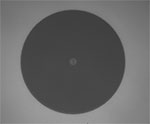
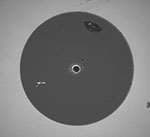
 SM Fiber-Based Polarization Beam Combiner/Splitter
SM Fiber-Based Polarization Beam Combiner/Splitter